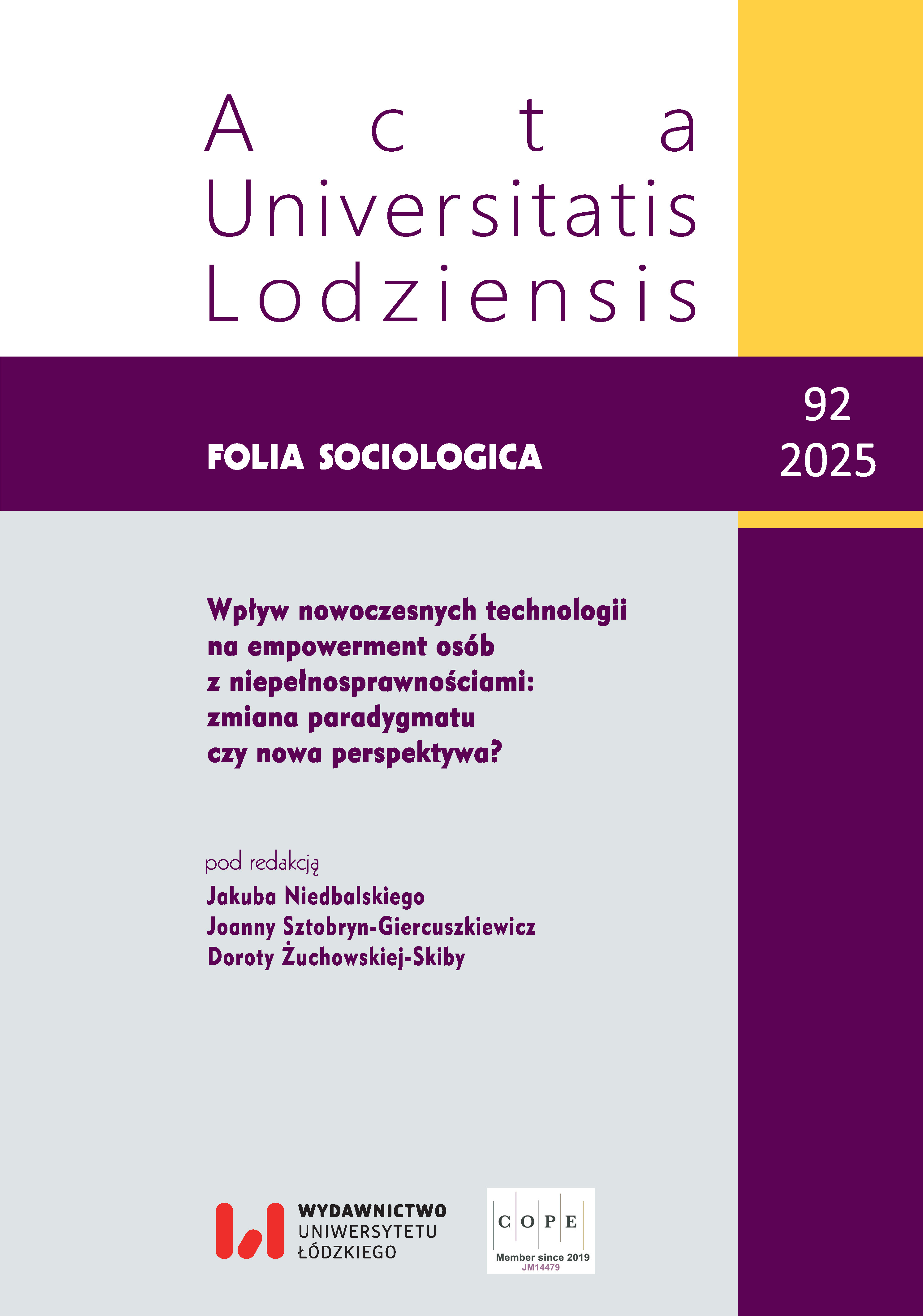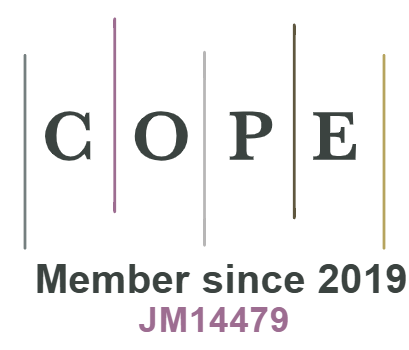Edukacja w zakresie świadomości niepełnosprawności z wykorzystaniem technologii Virtual & Mixed Reality – potencjał i wyzwania
DOI:
https://doi.org/10.18778/0208-600X.92.06Słowa kluczowe:
niepełnosprawność, edukacja, VR, projektowanie uniwersalne, szkolnictwo wyższe, krytyczne studia nad niepełnosprawnościąAbstrakt
Celem artykułu jest poddanie krytycznej refleksji wyzwań związanych z wykorzystaniem nowoczesnych technologii (w tym przypadku narzędzi Virtual/Mixed Reality) do celów edukacyjnych w zakresie treningów świadomości niepełnosprawności (disability awarness training). Dotychczasowa literatura przedmiotu pokazuje duży potencjał narzędzi VR w szkoleniach świadomościowych dotyczących różnych aspektów niepełnosprawności. Brak jednak krytycznych analiz dotyczących potencjalnych ryzyk w posługiwaniu się tego typu technologią w budowaniu obrazu osób z niepełnosprawnościami wśród studentów i innych grup uczestników szkoleń. W artykule, bazując na studium przypadku projektowania scenariuszy edukacyjnych w środowisku VR/MR, podjęto próbę wskazania potencjalnych zagrożeń z tego wynikających. Stereotypizacja obrazów osób z niepełnosprawnościami i głębokie osadzenie w medycznym modelu rozumienia niepełnosprawności oraz brak inkluzywności samego narzędzia to tylko niektóre z ryzyk, jakie mogą się pojawić przy projektowaniu i realizacji szkoleń świadomościowych za pomocą VR.
Bibliografia
AlBasri M. (2019), Learning Empathy Through Virtual Reality: A Mixed Methods Study, Harvard University Boston, Massachusetts.
Google Scholar
Campbell D.T., Stanley J.C. (1966), Experimental and Quasi-Experimental Designs for Research, Rand McNally, Chicago.
Google Scholar
Cook D.A., Hatala R., Brydges R., Zendejas B., Szostek J.H., Wang A.T., Erwin P.J., Hamstra S.J. (2011), Technology-enhanced simulation for health professions education: A systematic review and meta-analysis, „JAMA”, nr 306(9), s. 978–988. https://doi.org/10.1001/jama.2011.1234
Google Scholar
DOI: https://doi.org/10.1001/jama.2011.1234
Creed C., Al-Kalbani M., Theil A., Sarcar S., Williams I. (2023), Inclusive augmented and Virtual Reality: A research agenda, „International Journal of Human – Computer Interaction”, s. 1–20. https://doi.org/10.1080/10447318.2023.2247614
Google Scholar
DOI: https://doi.org/10.1080/10447318.2023.2247614
Davis M.H. (1983), Measuring individual differences in empathy: Evidence for a multidimensional approach, „Journal of Personality and Social Psychology”, nr 44(1), s. 113–126. https://doi.org/10.1037/0022-3514.44.1.113
Google Scholar
DOI: https://doi.org/10.1037//0022-3514.44.1.113
Davis M.H. (1999), Empatia. O umiejętności współodczuwania, Gdańskie Wydawnictwo Psychologiczne, Gdańsk.
Google Scholar
Davis R.L., Beel-Bates C., Jensen S. (2008), The longitudinal elder initiative: Helping students learn to care for older adults, „Journal of Nursing Education”, nr 47.4, s. 179–182.
Google Scholar
DOI: https://doi.org/10.3928/01484834-20080401-09
Diamond J. (1996), The roots of radicalism, „The New York Review of Books”, 14 November, s. 4–6.
Google Scholar
Fisher J.M., Walker R.W. (2014), A new age approach to an age old problem: Using simulation to teach geriatric medicine to medical students, „Age and Ageing”, t. 43.3, s. 424–428.
Google Scholar
DOI: https://doi.org/10.1093/ageing/aft200
Flyvbjerg B. (2005), Pięć mitów o badaniach typu studium przypadku, „Studia Socjologiczne”, nr 2(177), s. 41–69.
Google Scholar
Gaba D.M. (2004), The future vision of simulation in health care, „Quality and Safety in Health Care”, nr 13 (suppl 1), s. i2–i10. https://doi.org/10.1136/qshc.2004.009878
Google Scholar
DOI: https://doi.org/10.1136/qshc.2004.009878
Garland-Thompson R. (2018), Critical disability studies: A knowledge manifesto, [w:] M. Kent, R. Robertson (red.), Manifestos for the Future of Critical Disability Studies, Routledge, s. 11–19.
Google Scholar
DOI: https://doi.org/10.4324/9781351053341-2
Giedrojć M. (2021), Osoby z niepełnosprawnościami w Polsce w odbiorze społecznym. Uwagi na tle badań przeprowadzonych w 2019 roku, „Polityka i Społeczeństwo”, nr 4(19), s. 18–31. https://doi.org/10.15584/polispol.2021.4.2
Google Scholar
DOI: https://doi.org/10.15584/polispol.2021.4.2
Hehir T. (2002), Eliminating ableism in education, „Harvard Educational Review”, t. 1, nr 72, s. 1–33.
Google Scholar
DOI: https://doi.org/10.17763/haer.72.1.03866528702g2105
Jerald J. (2015), The VR Book: Human-centered Design for Virtual Reality, Morgan & Claypool, Liverpool.
Google Scholar
DOI: https://doi.org/10.1145/2792790
Kamińska D., Zwoliński G., Pinto-Coelho L., Raposo R. (2023), Universal design and empathic design for engineers, „Medycyna Pracy. Workersʼ Health and Safety”, nr 74(3), s. 211–225. https://doi.org/10.13075/mp.5893.01388
Google Scholar
DOI: https://doi.org/10.13075/mp.5893.01388
Lawson A., Beckett A.E. (2020), The social and human rights models of disability: Towards a complementarity thesis, „The International Journal of Human Rights”, nr 25(2), s. 348–379. https://doi.org/10.1080/13642987.2020.1783533
Google Scholar
DOI: https://doi.org/10.1080/13642987.2020.1783533
Mace R.L., Hardie G.J., Place J.P. (1991), Accessible Environments: Toward Universal Design, The Center for Universal Design, Raleigh.
Google Scholar
Milgram P., Kishino F. (1994), A taxonomy of Mixed Reality visual displays, „Transactions on Information Systems”, t. E77-D, nr 12.
Google Scholar
Moskalewicz J., Kiejna A., Wojtyniak B. (red.) (2012), Kondycja psychiczna mieszkańców Polski: raport z badań „Epidemiologia zaburzeń psychiatrycznych i dostęp do psychiatrycznej opieki zdrowotnej – EZOP Polska”, Instytut Psychiatrii i Neurologii, Warszawa.
Google Scholar
Pamuła N., Szarota M., Usiekniewicz M. (2018), „Nic o nas bez nas”, „Studia de Cultura”, nr 10(1). https://doi.org/10.24917/20837275.10.1.1
Google Scholar
DOI: https://doi.org/10.24917/20837275.10.1.1
Pinto-Coelho L., Queiros R., Reis S.S. (2021), Emerging Advancements for Virtual and Augmented Reality in Healthcare, IGI Global, Porto.
Google Scholar
DOI: https://doi.org/10.4018/978-1-7998-8371-5
Pinto-Coelho L., Laska-Leśniewicz A., Pereira E.T., Sztobryn-Giercuszkiewicz J. (2023), Inclusion and adaptation beyond disability: Using virtual reality to foster empathy, „Medycyna Pracy. Workersʼ Health and Safety”, nr 74(3), s. 171–185. https://doi.org/10.13075/mp.5893.01386
Google Scholar
DOI: https://doi.org/10.13075/mp.5893.01386
Pivik J., McComas J., MacFarlane I., LaFlamme M. (2002), Using Vitrual Reality to teach disability awareness, „Journal of Educational Computing Research”, t. 26(2), s. 203–218.
Google Scholar
DOI: https://doi.org/10.2190/WACX-1VR9-HCMJ-RTKB
Raposo R., Vairinhos M., Laska-Leśniewicz A., Sztobryn-Giercuszkiewicz J. (2023), Increasing awareness and empathy among university students through immersive exercises – Testing of the virtual reality application: A pilot study, „Medycyna Pracy. Workersʼ Health and Safety”, t. 74(3), s. 187–197. https://doi.org/10.13075/mp.5893.01391
Google Scholar
DOI: https://doi.org/10.13075/mp.5893.01497
Roberts D., Mason J., Williams E.N., Macpherson R. (2016), Promoting empathy through immersive learning, „Journal of Nursing Education and Practice”, nr 6.8, s. 1–8.
Google Scholar
DOI: https://doi.org/10.5430/jnep.v6n8p1
Scavarelli A., Arya A., Teather R.J. (2021), Virtual reality and augmented reality in social learning spaces: A literature review, „Virtual Reality”, nr 25, s. 257–277.
Google Scholar
DOI: https://doi.org/10.1007/s10055-020-00444-8
Schmidt M., Schmidt C., Glaser N., Beck D., Lim M., Palmer H. (2021), Evaluation of a spherical video-based virtual reality intervention designed to teach adaptive skills for adults with autism: A preliminary report, „Interactive Learning Environments”, nr 29.3, s. 345–364.
Google Scholar
DOI: https://doi.org/10.1080/10494820.2019.1579236
Sochańska-Kawiecka M., Kołakowska-Seroczyńska Z., Zielińska D., Makowska-Belta E., Ziewiec P. (2017), Badanie potrzeb osób niepełnosprawnych. Raport końcowy, PFRON, Warszawa.
Google Scholar
Sweeney K., Baker P. (2018), Promoting empathy using video-based teaching, „The Clinical Teacher”, nr 15.4, s. 336–340.
Google Scholar
DOI: https://doi.org/10.1111/tct.12693
Wong A., Gillis H., Peck B. (2017), VR Accessibility. Survey for People with Disabilities, https://www.ben-peck.com/papers/VR_Accessibility_Survey.pdf (dostęp: 12.06.2024).
Google Scholar
Zwoliński G., Kamińska D., Haamer R.E., Pinto-Coelho L., Anbarjafari G. (2023). Enhancing empathy through virtual reality: Developing a universal design training application for students, „Medycyna Pracy. Workersʼ Health and Safety”, nr 74(3), s. 199–210, https://doi.org/10.13075/mp.5893.01407
Google Scholar
DOI: https://doi.org/10.13075/mp.5893.01407
Opublikowane
Jak cytować
Numer
Dział
Licencja

Utwór dostępny jest na licencji Creative Commons Uznanie autorstwa – Użycie niekomercyjne – Bez utworów zależnych 4.0 Międzynarodowe.










